Home > The castle complex > Castle Park > History of the Park
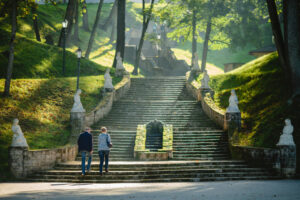 Cēsis Castle Park`s hills and ravines, cultural and historical monuments located in one small place made this the most favourable location for the successful creation of the park landscape more than 170 years ago. When forming landscape parks in Europe and Vidzeme other nobles also ordered artificial ruins to be built. Within Count`s Carl Gustav von Sievers territory, there already existed, Cēsis Castle stone ruins which were built during the reign of the Livonian Order, 14th – 16th century, naturally formed part of the park’s landscape created during 1832 – 1833. In addition to the ruins ancient Riekstu hill’ s silhouette (10th – 13th century), Cēsis manor buildings (18th – 19th century), 19th century brewery – predecessor of modern “Cēsis Beer” (Cēsu Alus), and Transfiguration of Christ Orthodox Church (consecrated in 1845) where Castle Park founder`s and his family cemetery is located, also became an integral part of the park’s scenery .From the western edge of the park, overlooking the city’s modern skyline there are hospital buildings, terraced houses and apartment blocks.
Cēsis Castle Park`s hills and ravines, cultural and historical monuments located in one small place made this the most favourable location for the successful creation of the park landscape more than 170 years ago. When forming landscape parks in Europe and Vidzeme other nobles also ordered artificial ruins to be built. Within Count`s Carl Gustav von Sievers territory, there already existed, Cēsis Castle stone ruins which were built during the reign of the Livonian Order, 14th – 16th century, naturally formed part of the park’s landscape created during 1832 – 1833. In addition to the ruins ancient Riekstu hill’ s silhouette (10th – 13th century), Cēsis manor buildings (18th – 19th century), 19th century brewery – predecessor of modern “Cēsis Beer” (Cēsu Alus), and Transfiguration of Christ Orthodox Church (consecrated in 1845) where Castle Park founder`s and his family cemetery is located, also became an integral part of the park’s scenery .From the western edge of the park, overlooking the city’s modern skyline there are hospital buildings, terraced houses and apartment blocks.
 According to the period and fashion, the Castle Park was designed by the castle-owner K.G. von Sievers (1772-1856) as a family recreation area with promenades. Riekstu hill was also included in the park, but the adjacent castle ruins and the mirror reflection of the pond created the necessary romantic mood. The description of Cēsis in the book “The Baltic provinces” (1841) J. Kols pointed to it as a favourite destination, “Students of Tartu, whose promised Land is Cēsis, frequently make trips on foot during summertime. Like Goethe followers to Harz, Heidelberg people to Odenwald and Breslaw people to Carpathians.”
According to the period and fashion, the Castle Park was designed by the castle-owner K.G. von Sievers (1772-1856) as a family recreation area with promenades. Riekstu hill was also included in the park, but the adjacent castle ruins and the mirror reflection of the pond created the necessary romantic mood. The description of Cēsis in the book “The Baltic provinces” (1841) J. Kols pointed to it as a favourite destination, “Students of Tartu, whose promised Land is Cēsis, frequently make trips on foot during summertime. Like Goethe followers to Harz, Heidelberg people to Odenwald and Breslaw people to Carpathians.”
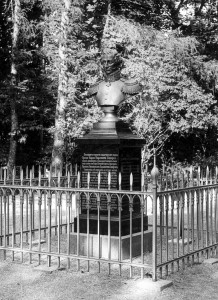 In the mid 19th century the northern part of the park was included in the castle-landlords family walking route which also overlooked fields and a recreational area. The Park’s redevelopment plan, showed benches, gazebos and a patio. The Castle Park creators gave specific place names for the castle park objects. Carl Hill near the pond was named in honour of the castle park creator Count Carl Gustav von Sievers. In 1908 his son Emanuel Sievers placed a bronze bust podium of Count Carl Gustaf von Sievers inscribed with his gallantry during the Napoleonic War (1812-1814) and Castle Manor development. Other places Carl Gustav devoted to his closest family members: Charlotte Island – in honour of his sister, Anna gates – sister; Alexander Hill – son, Minadora Hill with benches, and later with an arbour – daughter; Emanuel hill with terrace – son, resting places with benches he devoted to his daughter Sophie, her husband Gudim-Levkovich and granddaughter Sophie. He also created a viewing platform and benches on Rieksu hill devoting them to Minadora’s husband Muhanov, father`s cousin Elizabeth Ikskil. The park was a pleasant family garden haven, safe from townspeople’s curiosity – protected with a fence around the park. However, the park could be visited by travellers. In May 1874 Anton Birzgalis saw “that pond and that water, which also has two swans.” K. Bedeker’s guide “Russland” (1904) noted that for visiting the park and ruins, travellers have to pay 20 kopeck. It is thought that in the evening the park gates were closed and locked.
In the mid 19th century the northern part of the park was included in the castle-landlords family walking route which also overlooked fields and a recreational area. The Park’s redevelopment plan, showed benches, gazebos and a patio. The Castle Park creators gave specific place names for the castle park objects. Carl Hill near the pond was named in honour of the castle park creator Count Carl Gustav von Sievers. In 1908 his son Emanuel Sievers placed a bronze bust podium of Count Carl Gustaf von Sievers inscribed with his gallantry during the Napoleonic War (1812-1814) and Castle Manor development. Other places Carl Gustav devoted to his closest family members: Charlotte Island – in honour of his sister, Anna gates – sister; Alexander Hill – son, Minadora Hill with benches, and later with an arbour – daughter; Emanuel hill with terrace – son, resting places with benches he devoted to his daughter Sophie, her husband Gudim-Levkovich and granddaughter Sophie. He also created a viewing platform and benches on Rieksu hill devoting them to Minadora’s husband Muhanov, father`s cousin Elizabeth Ikskil. The park was a pleasant family garden haven, safe from townspeople’s curiosity – protected with a fence around the park. However, the park could be visited by travellers. In May 1874 Anton Birzgalis saw “that pond and that water, which also has two swans.” K. Bedeker’s guide “Russland” (1904) noted that for visiting the park and ruins, travellers have to pay 20 kopeck. It is thought that in the evening the park gates were closed and locked.
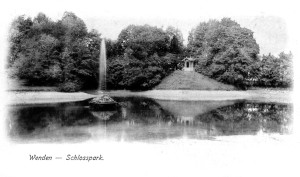 Parks became freely available to visitors and residents of Cēsis after Russian Tsar’s resignation from the throne in February 1917. From the 1920s until now, song festivals, theatre performances, concerts and balls have taken place. In the 1930s there were demonstrations of figure skating and ice skating for local people. Children enjoyed feeding the ducks and swans and sledging on steep slopes of the park.
Parks became freely available to visitors and residents of Cēsis after Russian Tsar’s resignation from the throne in February 1917. From the 1920s until now, song festivals, theatre performances, concerts and balls have taken place. In the 1930s there were demonstrations of figure skating and ice skating for local people. Children enjoyed feeding the ducks and swans and sledging on steep slopes of the park.
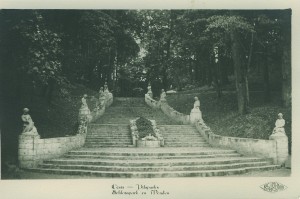 From 1935 the City Council took over the maintenance and improvement of the park. Steps were built as a safe passage to the pond (J. Rozenberg’s project). They are complemented by sculptor’s R. Āboltiņs travertine sculptures – figures of children at the step’s edges. At one end of the steps sculptor K. Jansons’ sculptures were installed. During the tourism campaign “Travel native land!” in 1936 a souvenir kiosk was built, which has remained unchanged in appearance until now. A small stage was built in 1938, it was extended in the 1960s. Also, the upper part of the steps were built in the 1960s. Also, in 1960s A. Jansons’ sculpture “Man with a catfish” was installed.
From 1935 the City Council took over the maintenance and improvement of the park. Steps were built as a safe passage to the pond (J. Rozenberg’s project). They are complemented by sculptor’s R. Āboltiņs travertine sculptures – figures of children at the step’s edges. At one end of the steps sculptor K. Jansons’ sculptures were installed. During the tourism campaign “Travel native land!” in 1936 a souvenir kiosk was built, which has remained unchanged in appearance until now. A small stage was built in 1938, it was extended in the 1960s. Also, the upper part of the steps were built in the 1960s. Also, in 1960s A. Jansons’ sculpture “Man with a catfish” was installed.
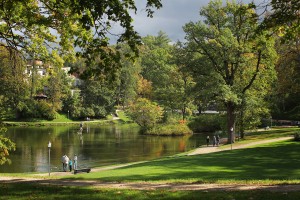 The park is still a favourite relaxation place for local people and visitors. The Latvian National Opera performances, Imants Kalniņš music concerts and Art festival are an indispensable event of the park and have become part of the Cēsis culture brand.
The park is still a favourite relaxation place for local people and visitors. The Latvian National Opera performances, Imants Kalniņš music concerts and Art festival are an indispensable event of the park and have become part of the Cēsis culture brand.